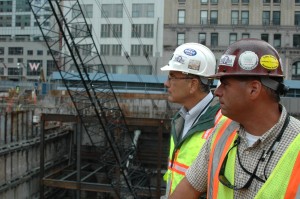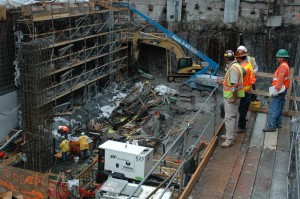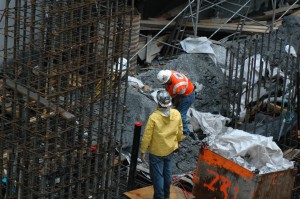
Rain kept away crowds of weekday tourists at the World Trade Center construction site as the 10th anniversary of the terrorist attacks approached. In an excavation pit at the south end lined by 80-foot-high slurry walls ”“ haunting images from the scenes of  devastation here a decade ago ”“ rain rolled off the hardhats of about 100 Yonkers Contracting Co. Inc. employees at work on an underground vehicle security center that will open next spring.
“We”™ve had almost a continuous presence down here since Sept. 11, 2001,” said John L. Kolaya, a civil engineer and executive vice president of Yonkers Contracting Co., a 65-year-old family business and full-service construction company. For him and James Strobel, the Yonkers company”™s New York City project director, “It”™s been a 10-year blur for both of us,” Kolaya said.

In that time, Yonkers Contracting has taken on at least half a dozen World Trade Center projects that total more than $630 million in contracts. The company has employed from 20 to as many as 1,000 workers on those projects. It has worked for city, state and regional agencies as well as the World Trade Center”™s private building owner, Silverstein Properties.
When the rebuilt complex is completed, most of the company”™s work will be out of sight, except for a pedestrian bridge north of the site that spans the West Side Highway. Yonkers Contracting completed that $15 million structural-steel project for the state Department of Transportation in 2007.

“You can”™t see our best work,” said Strobel. The vehicle security center, for example, the only point of vehicular access to the heavily secured site, for which Yonkers Contracting won a $66-million contract from the Port Authority, will lie beneath a public park.
“From Vesey to Albany Street,” said Kolaya, referring to the northern and southern bounds of the 16-acre World Trade Center site, “nothing that we built will be visible from the surface.”
“You”™ll see the sidewalk that we poured around the perimeter,” said Strobel. He laughed.

On the job, 24/7
Nine years ago, in some of the most challenging rebuilding work, Strobel directed a three-company team of contractors on the $460-million reconstruction of two PATH train stations and two mile-long train tunnels beneath the Hudson River that link the lower Manhattan site with Jersey City, New Jersey. Yonkers Contracting managed the urgent project, which included two Queens construction companies as co-contractors and about 25 subcontractors. In an unusual owner-contractor working relationship, Port Authority staff ”“ the agency”™s “best and brightest,” said Kolaya ”“ designed the project on the fly. The job”™s three sections were completed in 20 months, almost two months ahead of schedule.

“This was lightning speed in my mind,” said Kolaya. “We went around the clock seven days a week.”
“The job took on a life of its own,” said Strobel. “You went home for a few hours”™ sleep and you dreamt what you did today and what you were going to do tomorrow” on the reconstruction.
The engineers”™ connections to the World Trade Center site run deep.
Kolaya was a civil engineering student at Bucknell University when he first visited the World Trade Center on a group tour during its construction in 1969. The tour guide from Thomas Crimmins Contracting Co., whom he met on scaffolding on the site, offered him an internship and Kolaya went to work full-time for the company after graduation in 1970.

In 1987, Strobel went to work for Kolaya at Crimmins after his college graduation. His first job was at 7 World Trade Center, a tower destroyed in the 9/11 attacks and since rebuilt. Yonkers Contracting acquired the Crimmins company that same year, and with the purchase the two engineers moved from $2-million foundation jobs into multimillion-dollar heavy construction projects.
Stabilizing the structures
Ten years ago this month, Yonkers Contracting was rebuilding the Manhattan and Williamsburg bridges on the East River. “So we had hundreds of ironworkers working in the vicinity when 9/11 occurred,” said Kolaya. “They actually saw the planes flying over the Manhattan bridge ”“ which was not their usual flight path.” Seeing the planes fly into the towers, “Their immediate reaction was to run over and help.”
From Yonkers, “We came down the West Side Highway with a dozen pieces of equipment ready to go to work,” Kolaya said. Joining numerous other contractors and volunteers, Yonkers Contracting was assigned to recovery and debris removal work in the destroyed center”™s southeast quadrant.
After three days, about 50 Yonkers Contracting ironworkers went to work dismantling and removing steel on a $5 million subcontract.
In the weeks following the attacks, Kolaya was part of a volunteer geotechnical group that assessed the risks of collapse in the slurry walls that lined the “bathtub” in which the World Trade Center sat shielded from Hudson River flooding. Debris from the fallen towers held the damaged walls in place.
“It was a horrible enough tragedy to begin with, but if it filled with water, the entire downtown area would have been destroyed along with the subways and tunnels,” said Kolaya. The “think tank” team spent three to four months “to try to determine the safest way to remove the debris” and stabilize the underground walls.
In a $43 million project, Yonkers Contracting also was hired to do foundation work for towers 3 and 4 at the site by owner Silverstein Properties and the developer”™s construction manager, Tishman Construction Corp.
”˜Proud to be part of it”™
Currently the Yonkers company is working for the Port Authority on both the vehicle security center and a $43-million, security-sensitive project to strengthen the PATH train tunnels under the Hudson.
The PATH project, said Strobel, “is all off-shift work when you can stop one of the tunnels at night. It”™s very difficult because you can”™t shut it down for any continuous period of time.”
Though the Westchester company has done much at the World Trade Center in the last decade, “We bid a lot of work that we didn”™t get,” said Kolaya. The company finished second in bidding, behind Skanska, the Swedish construction giant, on a $500-million project to build a PATH World Trade Center transportation hub that will replace the temporary station that was delivered early by the Yonkers Contracting team.
“If we had won that contract, we”™d be all over the place” on the site, Kolaya said.
Still the Yonkers contractor has gotten about one out of three World Trade Center projects on which it bid. “That”™s because we know the work down here so well,” Kolaya said.
The massive cooperative effort seen on 9/11 has continued at the site through the rebuilding.
“There”™s probably no other place in the city where you can be thrown together with so many contractors and still have everything go smooth and move forward,” said Kolaya. “It”™s an enormous undertaking as far as coordination is concerned. Nowhere else in the city would you see a project with this cooperation.”
“It”™s been a great experience to be part of rebuilding down here,” Strobel said. “I”™m certainly proud to be part of it.”
Photography by Ryan Doran



















